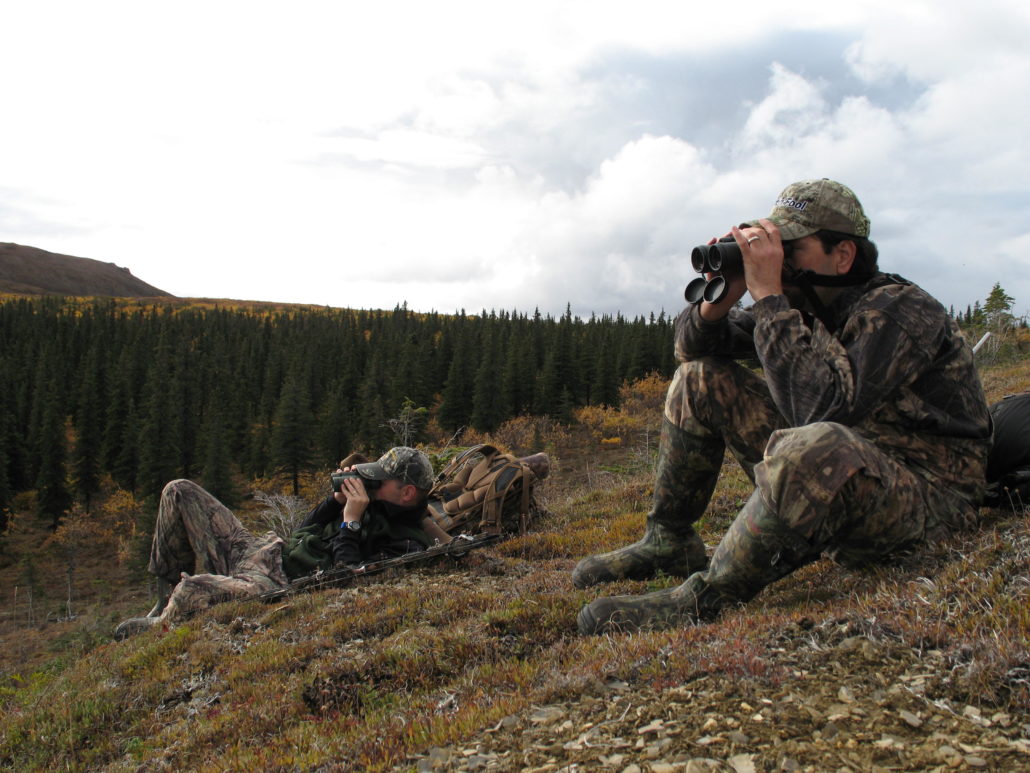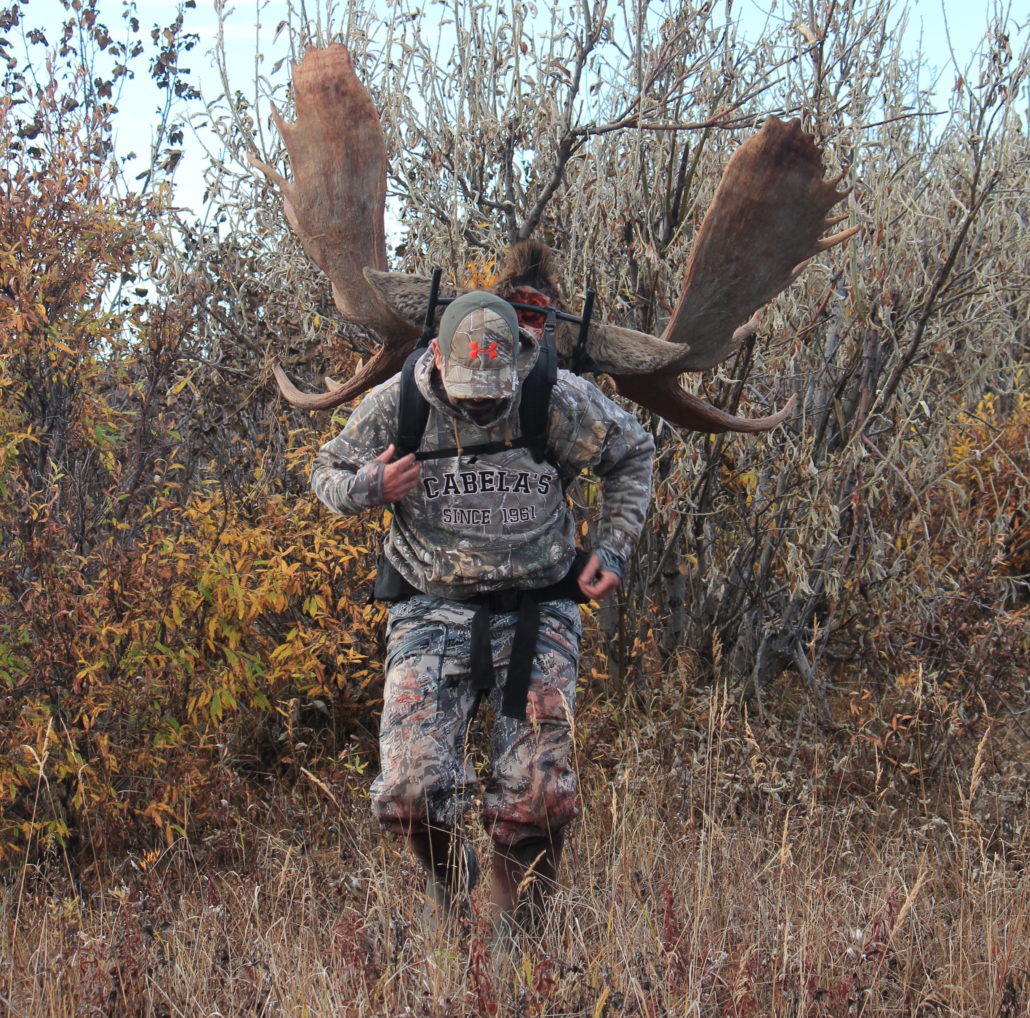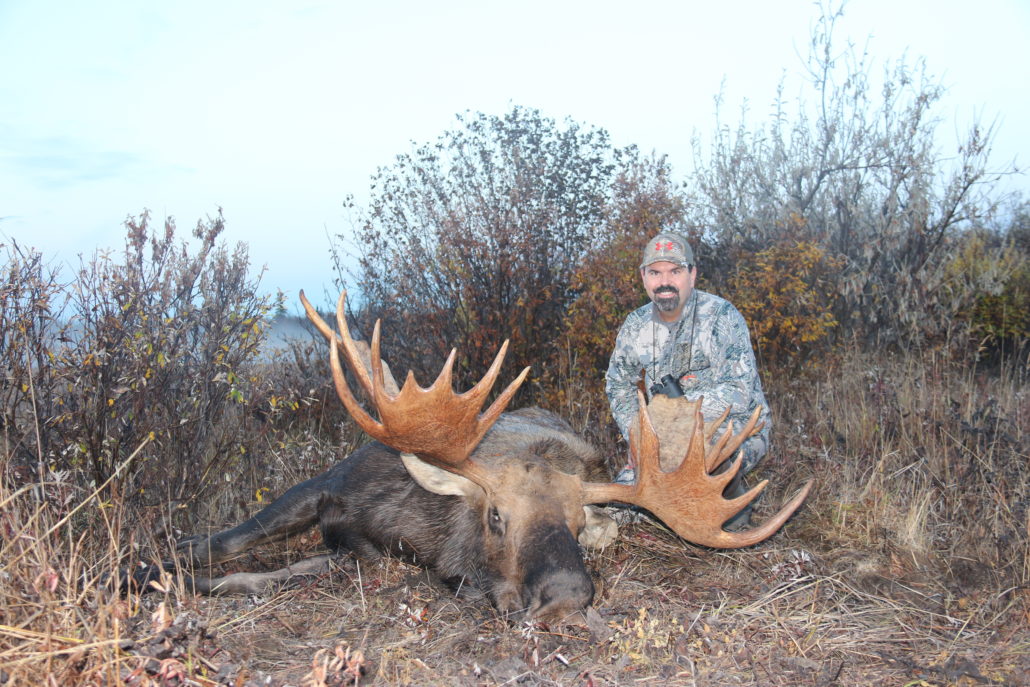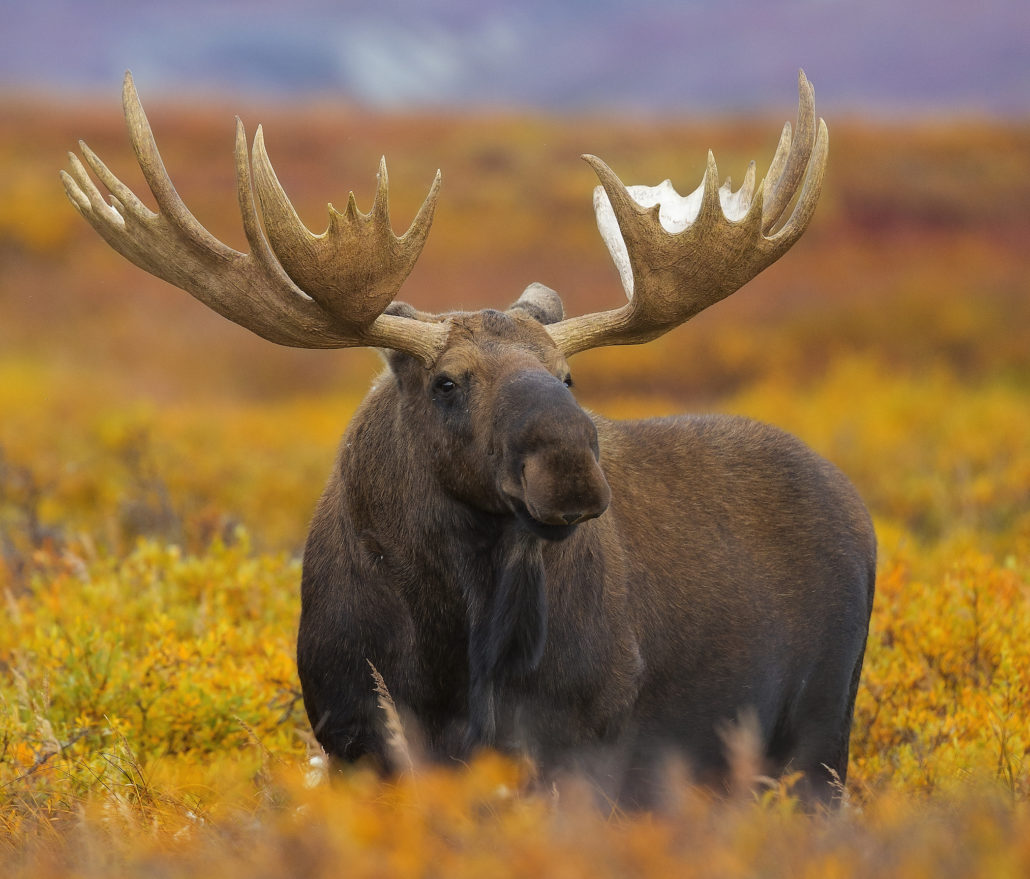Moose Success
By
Paul D. Atkins
Big bulls can weigh close to 1800 pounds and stand over six feet at the shoulder. With this height also comes their shear mass, big bodied and a skeletal structure that is built like a tank.
I could see the bull long before I got to him; he wasn’t a monster, but a respectable bull, nonetheless. This was the last day of the hunt and I knew I wanted to try and take him but getting to a spot where I could get a shot would be the tricky part.
Moose are very big animals and if you haven’t been up close to one then you have no idea what I’m talking about. Big bulls can weigh close to 1800 pounds and stand over six feet at the shoulder. With this height also comes their shear mass, big bodied and a skeletal structure that is built like a tank.
I’ll be the first to say that moose hunting isn’t that difficult. Here in Alaska it seems they’re standing on every corner or behind every willow and if you think I’m kidding just go to downtown Anchorage sometime. Even here in rural Alaska they aren’t that hard to find, but finding the right one, the glorified 60 plus bull may prove a little more difficult.
When I first arrived in Alaska back in the 90’s getting a moose with archery gear was my number one priority. Sure, everyone wants to shoot a caribou or two, but a moose, the largest of the deer family was the pinnacle of any trip to the tundra.
After spending most of my life bow hunting whitetails and here with no deer in sight I came to the conclusion that moose would become my whitetail. What I didn’t understand at the time was how much different bow hunting moose and bow-hunting deer can be. For sure there are ton of differences, the terrain, the enormity of them, the idea of seeing that monster and getting him back to camp or how much more aggressive you have to be all come to mind. It took me several years to figure it all out, but through a lot of trial and error here is what I’ve learned.

Where to Go
Moose can be found in almost all of Alaska. There are some parts however such as Kodiak and many of the islands where moose do not exist, but as far as the interior they are there and in pretty good numbers. If you are thinking about a moose hunt, then you probably need to start looking at one or more of the many river drainages that flow here in the state. I have found that bow hunting along rivers is your best bet on arrowing a good bull, stalking willow thickets with the occasional” open spot” can be a bow hunter dream and provide about as much excitement as it can get. Rivers here go for miles and depending how far you want to go from camp the hunting can be endless, this combined with the long days of September you can practically hunt 14-15 hours per-day.

Archery Equipment
About any archery set-up will work. However, the state does require that a bow have a minimum of 50 pounds draw weight and a broad head with at least 7/8 cutting diameter. There really isn’t any secret or special gadget to be successful when it comes to moose. If I had to choose one, then I would say it’s the type of broad head you use. There are hundreds out there to choose from, but when you’re a thousand miles from home and out a few thousand bucks you better make sure you choose the right one
Moose are big as I said earlier, and their ribs are put together like steel shingles. To successfully get an arrow into them let alone a pass through can sometimes be a tough task. I myself have used several types of broad heads on moose and all have resulted in clean kills. Penetration however has been a different story. Ideally like all animals we would like to get a complete pass through, and I have found that solid one-piece heads do the best job. I personally like the G5 line and the Montec in particular. I have taken several moose with this broad head and at several distances, each have been a complete pass through.
Rifle
Like I said moose are big formattable creatures and choosing a rifle that you can shoot well is a must. I recommend anything in the 300 caliber, but I’ve also taken many with my 7 mag. Make sure you have a reliable scope and it also well help if you have a set of shooting sticks just in case.
Gear
After you have selected your bow set-up and get things dialed in then its time to figure out the rest of your gear. With high cost of flying these days and the ever-increasing cost of baggage a bow hunter needs to choose his or her gear carefully. You will of course have a bow case and I suggest you find something big and as light as possible. There are many reasons for this. First you not only can include you bow, arrows, releases, broad heads, binoculars, rangefinder and a small accessory kit you can also pad it with a lot more clothes than you think.
First and foremost, after your bow case you should have a good set of rain gear. I have bow hunted moose every September for the last 15 years and on each and every one of those hunts it has rained. Your rain gear should be durable, comfortable and more importantly allow you to draw your bow with no restrictions. Fleece layering is another big plus, plus several pair of socks. You will also need a good set of waders if you plan to bow hunt moose. River crossings are sometimes endless and with a ton of walking will require something pass your knees. Waders don’t breathe well either, so at the end of the day your socks will be soaked. Believe me nothing is better than putting on a dry pair of socks at the end of the day.
I also use a dry bag instead of a suitcase. Dry bags come in several sizes and weigh practically nothing. All your gear plus the fact that you can leave the bag outside closed will prevent your stuff from getting wet.
¨Whether you decide to go at alone or hire a guide you will have a great time hunting for moose. If you do decide to DIY you will also have to think about gear other than what I mentioned above. Tents, food, cooking gear, game bags, frame packs and an assortment of other needs will have to be addressed.¨
Types Hunting
Hunting moose is sometimes a hit and miss operation, but like all hunting if you work hard and are in the right place at the right time you will succeed. I have tried many methods on moose and have had some success with each.
Using a good pair of binoculars and finding a high vantage point to glass is probably your best bet. Once you’re in the air on route to the area where you will hunt you will need to make some decisions before the pilot drops you off. It’s been my experience to make a few passes over the area you will be hunting and have the transporter drop you near an area that at least has a high point or a least a few hills. This way you can climb up and get a better view of the area and see what it really has to offer. This has worked great for me personally. Climb up, survey the surroundings and hopefully locate some moose, then breakout the spotting scope to get a closer view.
Another technique is to take off from camp using spot and stalk. You will need to pay close attention to the wind, but this combined with calling can be very effective with moose especially during the rut in September. It also can get pretty exciting in a real big hurry. There is nothing like calling in a big bull only to have him bust out in front of you at 10-15 yards.
Be Prepared
Hunting moose doesn’t require a guide here in Alaska and most tags can be obtained through a pretty liberal drawing held each February. Guided hunts can be quite expensive; so, most hunters do the “do-it-yourselfer” and go out on their own. In my opinion it is the only way to go. 5-7 days on the tundra with bow or rifle in hand is not only an ultimate adventure, but also true a test of your hunting skills. But like all hunts in Alaska it’s not for the weak hearted and it can be tough, bordering on the extreme at times. Finding and taking that bull of a lifetime can and will be the highlight of the hunt but getting 1800 pounds of him back to camp and then back home can be a different story. In addition to that a hunter has to be ready for all that the great outdoors and a hunt like this have to offer. Whether it’s constant rain, mosquitoes, an upset bush pilot or the ever-constant threat of bears you have to be prepared and have the brains to get things done and in some cases survive.
The bull was standing on the edge of a riverbank with his nose stuck in the water. Not knowing exactly how I would cut the distance I decided that each time he put his head down I would weave in and out of the willows until I could get into bow range. My hope at the time was that he wouldn’t decide to venture back into the wall of willows where there would be no chance. I love when a plan works and with each dip of his head, I made a move. This worked and the final reading on the rangefinder said he was broadside at 43 yards. Carefully drawing the Bowtech Allegiance I hoped to place the Carbon Express arrow right behind his shoulder. At the release I knew it was good and as I seen the fletching disappear, I wondered if he would go into the water or turn to the willows.

(SIDE NOTE)
The application period for drawing an Alaskan moose permit is during the month of December. Applications can be done through the mail or on the Internet. A person must first buy a hunting license, which can also be bought on-line for $85, which is still quite cheap compared with cost of other non-resident licenses in the lower 48. An applicant will get 6 choices; so, make sure you do your homework when you it comes to choosing the area you want to hunt. Look at record books (if that is your thing) to see where the big bulls are being killed or probably more beneficial contact a biologist at Alaska Fish and Game. They live in that area and know exactly what the moose populations are and the success ratios from years past.
Whether you decide to go at alone or hire a guide you will have a great time hunting for moose. If you do decide to DIY you will also have to think about gear other than what I mentioned above. Tents, food, cooking gear, game bags, frame packs and an assortment of other needs will have to be addressed. There are few outfits here in the state that actually rent gear and will be happy to set you up with all the necessities that will make your hunt a success. Most of these can be found on the Internet. Also, you will need to hire yourself a transporter to get you to and from the field. Again, you will need to do your homework and find somebody with a lot of experience and a pilot that knows the area. In addition, you will need to plan this far in advance, as they tend to book early and often.
Paul Atkins is an outdoor writer and author from Kotzebue, Alaska. He has written hundreds of articles on big game hunting, and fishing throughout North America and Africa, plus surviving in the Arctic.
Share this entry
- big-game
- hunting
Interesting links
Here are some interesting links for you! Enjoy your stay :)Pages
- About
- Accesories
- Accesories & Equipment
- Accesories & Equipment
- Advertisement Contact
- Ammo
- Big Game
- Blog
- Bow Hunting
- Cart
- Community
- Deer
- Download Hafaspot
- Equipment
- FAQ
- Fire Arms
- Fishing
- Fresh Water
- Grill
- Home
- Home | FIND YOUR SPOT
- home 2
- Hunting
- Login and registration
- Lures
- My Account
- News
- News
- News
- Página de ejemplo
- Payment
- Prime Cuts Recipes
- Salt Water
- Shooting
- Small Game
- Store
- Targets
- Wild Caught Recipes
- Wild Game Recipes



